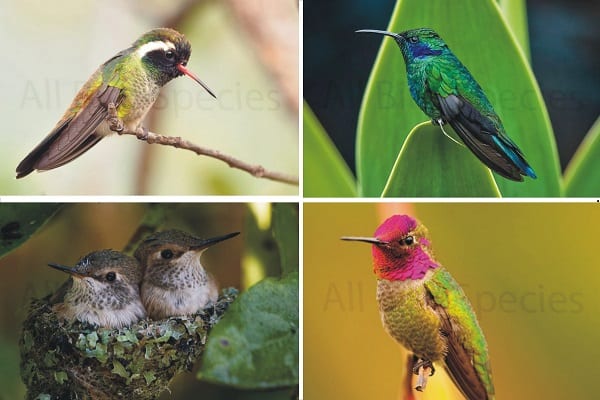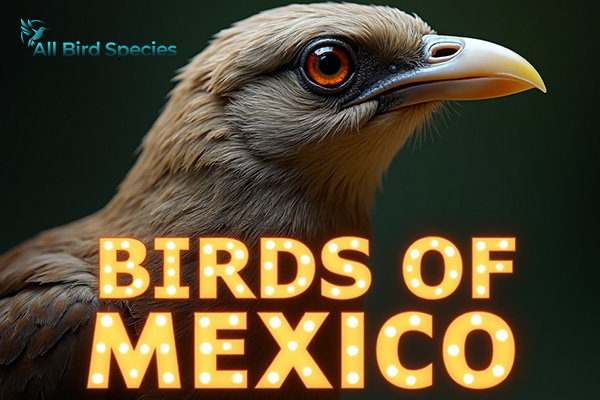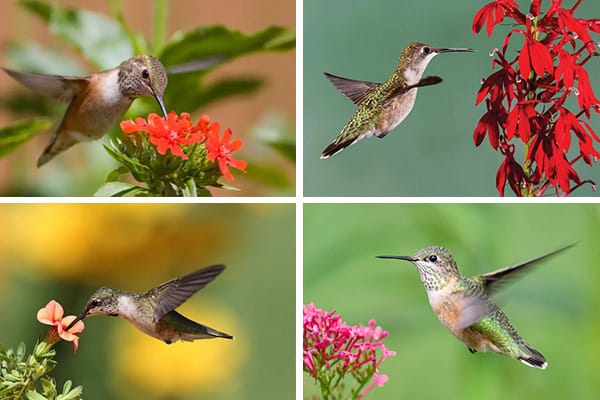6 Types Of Hummingbirds in Michigan With Photos (2024)
Hummingbirds in Michigan are a delight to watch. They are small, colorful, and fast-moving birds that can hover and fly in any direction. You might think that Michigan is too cold for them, but there are actually six kinds of hummingbirds that visit or live in this state. In this article, I will introduce you to these amazing birds and share some tips on how to attract them to your backyard.
Types Of Hummingbirds in Michigan (Common and Rare)
1. Ruby-throated hummingbird

The Ruby-throated hummingbird (Archilochus colubris) is a captivating species of hummingbird found in eastern North America. Here are some fascinating details about this tiny jewel of the avian world:
Appearance:
- Size: Measuring approximately 7 to 9 centimeters (2.8 to 3.5 inches) in length, with a wingspan of 8 to 11 centimeters (3.1 to 4.3 inches).
- Coloration: Adults have metallic green upperparts and grayish white underparts. Their wings appear near-black. The male boasts an iridescent ruby-red throat (gorget) bordered with velvety black, while the female has a white throat with possible dusky streaks or stipples.
- Tail: The male has a forked black tail with a faint violet sheen, while the female’s tail is notched and banded in green, black, and white.
Range and Migration:
- Wintering Grounds: During winter, Ruby-throated hummingbirds retreat to Central America, Mexico, and Florida.
- Breeding Season: They migrate to Canada and other parts of Eastern North America for the summer breeding season.
- Population: With an estimated population of about 35 million in 2021, they are the most common hummingbirds in the eastern region of North America.
Taxonomy and History:
- Scientific Name: The species was formally described by Carl Linnaeus in 1758 as Trochilus colubris.
- Genus: It now belongs to the genus Archilochus, introduced by Ludwig Reichenbach in 1854.
- Type Locality: The type locality is South Carolina.
- Name Origin: The specific epithet colubris comes from the Spanish word “colibrí,” meaning “hummingbird.”
Unique Features:
- Bill: Their long, straight, and slender bills can reach up to 2 centimeters (0.79 inches).
- Toe Arrangement: Hummingbirds have short legs without knees. Their feet have three toes pointing forward and one backward (the hallux), which helps them grip flower stems or petals.
- Sexual Dimorphism: The male’s iridescent ruby-red gorget and forked tail distinguish it from the female.
Behavior:
- Hovering: Ruby-throated hummingbirds can hover in place while feeding on nectar.
- Feeding: They visit nectar-filled feeders and native flowering plants.
- Migration: Their impressive migration covers thousands of miles.
Must Read: Birds With Mohawks
2. Rufous Hummingbird

The Ruby-throated hummingbird (Archilochus colubris) is a captivating species of hummingbird found in eastern North America. Here are some fascinating details about this tiny jewel of the avian world:
Appearance:
- Size: Measuring approximately 7 to 9 centimeters (2.8 to 3.5 inches) in length, with a wingspan of 8 to 11 centimeters (3.1 to 4.3 inches).
- Coloration: Adults have metallic green upper parts and grayish white underparts. Their wings appear near-black. The male boasts an iridescent ruby-red throat (gorget) bordered with velvety black, while the female has a white throat with possible dusky streaks or stipples.
- Tail: The male has a forked black tail with a faint violet sheen, while the female’s tail is notched and banded in green, black, and white.
Range and Migration:
- Wintering Grounds: During winter, Ruby-throated hummingbirds retreat to Central America, Mexico, and Florida.
- Breeding Season: They migrate to Canada and other parts of Eastern North America for the summer breeding season.
- Population: With an estimated population of about 35 million in 2021, they are the most common hummingbirds in the eastern region of North America.
Taxonomy and History:
- Scientific Name: The species was formally described by Carl Linnaeus in 1758 as Trochilus colubris.
- Genus: It now belongs to the genus Archilochus, introduced by Ludwig Reichenbach in 1854.
- Type Locality: The type locality is South Carolina.
- Name Origin: The specific epithet colubris comes from the Spanish word “colibrí,” meaning “hummingbird.”
Unique Features:
- Bill: Their long, straight, and slender bills can reach up to 2 centimeters (0.79 inches).
- Toe Arrangement: Hummingbirds have short legs without knees. Their feet have three toes pointing forward and one backward (the hallux), which helps them grip flower stems or petals.
- Sexual Dimorphism: The male’s iridescent ruby-red gorget and forked tail distinguish it from the female.
Behavior:
- Hovering: Ruby-throated hummingbirds can hover in place while feeding on nectar.
- Feeding: They visit nectar-filled feeders and native flowering plants.
- Migration: Their impressive migration covers thousands of miles.
3. Anna’s Hummingbird
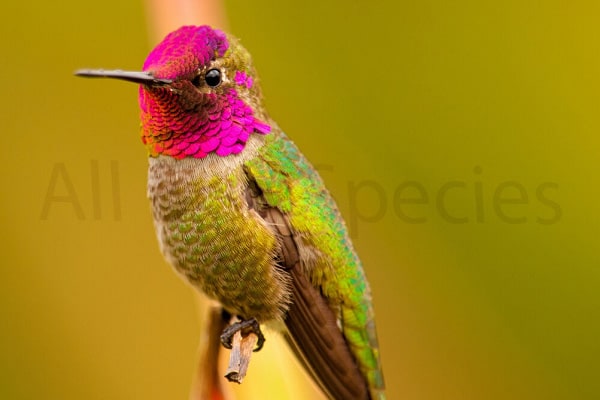
Anna’s hummingbird (Calypte anna) is a North American species of hummingbird. It was named after Anna Masséna, Duchess of Rivoli. Here are some intriguing details about this hardy little bird:
Appearance:
Size: Measuring around 3.9 to 4.3 inches (9.9 to 10.9 cm) in length, with a wingspan of 4.7 inches (12 cm) and a weight range of 0.1 to 0.2 oz (2.8 to 5.7 g).
Coloration:
- Male: The adult male has an iridescent crimson-red crown and gorget, which can look dull brown or gray without direct sunlight. His back is bronze-green, his chest and belly are pale gray, and his flanks are green. His tail is slightly forked.
- Female: Females also have iridescent red gorgets, although they are usually smaller and less brilliant than the male. Their crown is dull green, throat gray with or without some red iridescence, chest and belly gray, and tail dark with white tips on the outer feathers.
Range and Habitat:
- Breeding Range: Anna’s hummingbirds breed along the western coastal regions of North America, including northern Baja California and Southern California.
- Year-Round Residents: Some Anna’s hummingbirds reside year-round in the Pacific Northwest, thanks to acclimation to colder winter temperatures, introduced plants, and human provision of nectar feeders during winter.
Behavior and Diet:
- Feeding: These birds primarily feed on nectar, using their long extendable tongues. They also consume small insects and other arthropods caught in flight or gleaned from vegetation.
- Territorial: Anna’s hummingbirds are known for their territorial behavior, dominating feeders and flower patches.
Taxonomy and History:
- Scientific Name: Anna’s hummingbird was formally described and illustrated in 1829 by the French naturalist René Lesson. It was initially placed in the genus Ornismya and named Ornismya anna. It now belongs to the genus Calypte, introduced by the English ornithologist John Gould.
- Name Origin: The specific epithet anna honors Anne d’Essling, who married the ornithologist François Victor Massena, 3rd Duke of Rivoli.
- Monotypic Species: No subspecies are recognized.
Also Read: Cardinals Appear When Angels Are Near
4. Broad-Billed Hummingbird

The Broad-billed hummingbird (Cynanthus latirostris) is a small-sized hummingbird that resides in Mexico and the southwestern United States. Here are some intriguing details about this vibrant little bird:
Appearance:
Size: Measuring around 3.9 to 4.3 inches (9.9 to 10.9 cm) in length, with a wingspan of 4.7 inches (12 cm) and a weight range of 0.1 to 0.2 oz (2.8 to 5.7 g).
Coloration:
Male: The adult male has an iridescent crimson-red crown and gorget, which can look dull brown or gray without direct sunlight. His back is bronze-green, chest and belly are pale gray, and flanks are green. His tail is slightly forked.
Female: Females also have iridescent red gorgets, although they are usually smaller and less brilliant than the male. Their crown is dull green, throat gray with or without some red iridescence, chest and belly gray, and tail dark with white tips on the outer feathers.
Range and Habitat:
Breeding Range: Broad-billed hummingbirds breed along the western coastal regions of North America, including northern Baja California and Southern California.
Year-Round Residents: Some Broad-billed hummingbirds reside year-round in the Pacific Northwest, thanks to acclimation to colder winter temperatures, introduced plants, and human provision of nectar feeders during winter.
Behavior and Diet:
Feeding: These birds primarily feed on nectar, using their long extendable tongues. They also consume small insects and other arthropods caught in flight or gleaned from vegetation.
Territorial: Broad-billed hummingbirds are known for their territorial behavior, dominating feeders and flower patches.
Taxonomy and History:
Scientific Name: Broad-billed hummingbirds were formally described in 1827 by William Swainson based on specimens collected by William Bullock in México. Swainson coined the binomial name Cynanthus latirostris.
Name Origin: The species name combines the Latin latus meaning “broad” with – rostris meaning “-billed.”
Must Explore: Birds That Lay Blue Eggs
5. Green-Violet Ear Hummingbird
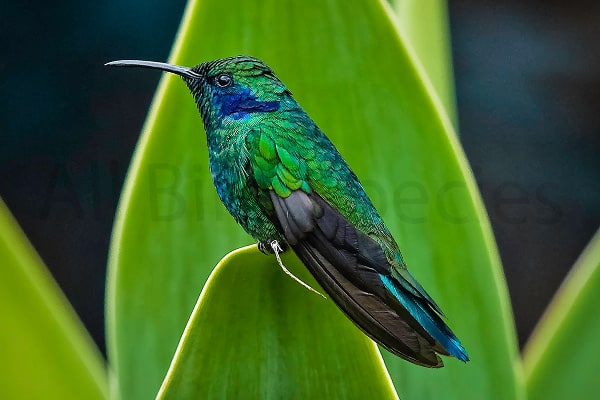
The Green Violet-ear hummingbird (Colibri thalassinus), also known as the Mexican Violet-ear, is a colorful and captivating hummingbird species found in various regions. Let’s delve into the fascinating details of this delightful bird:
Range and Habitat:
- Breeding Range: Green Violet-ears inhabit the highlands from south-central Mexico (specifically the Trans-Mexican Volcanic Belt) south to western Panama. They are also found in the Andes, spanning from northern Venezuela to Bolivia.
- Habitat: These hummingbirds thrive in forested areas, subtropical zones, and gardens. They prefer the canopy and borders of subtropical and lower temperate forests, secondary woodlands, scrub, and clearings.
Appearance:
Size: Green Violet-ears are roughly medium-sized by hummingbird standards, measuring around 9.7 to 12 cm (3.8 to 4.7 inches) in total length.
Coloration:
- Their upper parts shimmer in a brilliant green hue.
- The sides of their neck feature a glittering violet ear-patch.
- Their throat and chest exhibit a more intense green color.
- The belly shines in a similar green shade.
- The tail is metallic blue-green with bronzy central feathers and a prominent black subterminal band.
Vocalizations:
- Solitary males sing from high, exposed twigs in their territory every day.
- Their song consists of a monotonously repeated sharp and dry “tsu-tzeek” at a rate of about one call per second.
Taxonomy and Systematics:
- The Green Violet-ear belongs to the order Apodiformes, which includes hummingbirds and swifts.
- The name Apodiformes comes from the Greek words “a pous,” meaning “without foot,” highlighting their small feet and inability to walk.
- These birds spend most of their time in the air due to their weak legs and quick escape abilities.
Subspecies:
- The Green Violet-ear has several subspecies:
- C. c. cabanidis: Found in Costa Rica and western Panama.
- C. c. cyanotus: Occurs in Colombia, northwestern Venezuela, and Ecuador.
- C. c. kerdeli: Found in northeastern Venezuela
6. White-eared hummingbird
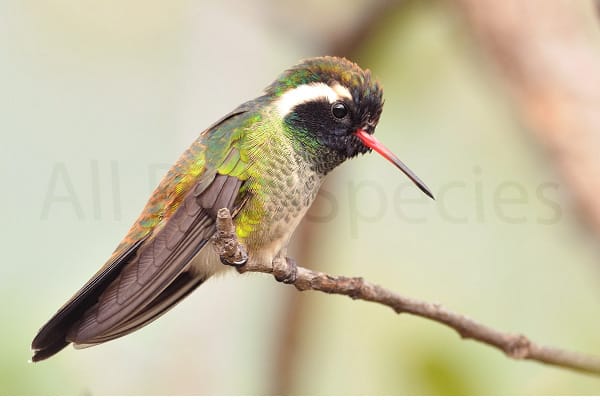
The White-Eared Hummingbird (Basilinna leucotis) is a captivating species of hummingbird found in montane regions across Mexico and Central America. Let’s explore some fascinating details about this delightful bird:
Appearance:
- Size: White-eared hummingbirds measure approximately 9 to 10 cm (3.5 to 3.9 inches) in length.
Coloration:
- Males: In breeding plumage, males have a metallic violet or bluish violet forehead, a mostly black face with a wide white stripe behind the eye, and a dull black crown. Their upper parts shimmer in bright metallic green to bronze-green, and their throat is violet blue. The breast and flanks are bronze to bronze green.
- Females: Females resemble males but lack the brilliant chin and throat. Their underparts are pale brownish gray to grayish-white with metallic bronze-green spots.
Range and Habitat:
- Breeding Range: White-eared hummingbirds inhabit the highlands from southern Arizona into the Mexican states of Sonora, Chihuahua, and Tamaulipas. They occasionally visit New Mexico and Texas and have been observed as vagrants further north and east in the U.S.
- Habitat: They thrive in forest clearings, edges of pine, pine-oak, and pine-evergreen forests. Their elevation range spans from 1,200 to 3,500 meters (3,900 to 11,500 feet).
Behavior and Diet:
- White-eared Hummingbirds feed primarily on nectar, using their long extendable tongues. They also consume small insects and other arthropods.
- They are known for their territorial behavior, dominating feeders and flower patches.
FAQ’s:
Q1: What months are hummingbirds in Michigan?
Hummingbirds are typically present in Michigan from late April to early October.
Q2: Do hummingbirds live in Michigan?
Yes, hummingbirds do live in Michigan.
Q3: What states are hummingbirds most common?
Hummingbirds are most common in the southern and western United States, including states like California, Texas, and Arizona.
Q4: Are hummingbirds rare in Michigan?
While the ruby-throated hummingbird is common, other species like the rufous hummingbird and broad-billed hummingbird are rarer
Q5: Do hummingbirds lay eggs in Michigan?
Yes, hummingbirds lay eggs in Michigan. They build tiny nests and lay their eggs during the warmer months.
What time of year do hummingbirds mate in Michigan?
Hummingbirds mate during the spring and early summer in Michigan.

